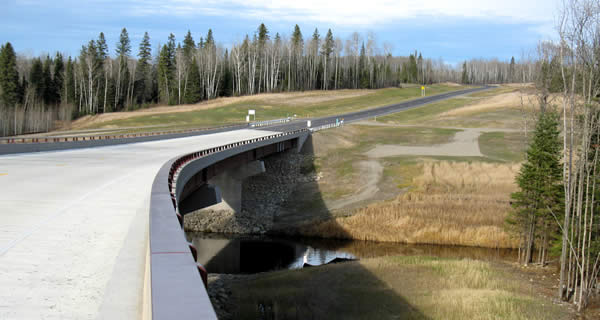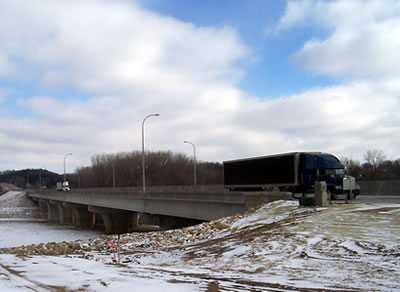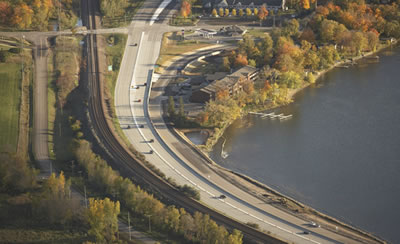By Craig Wilkins

A new bridge carries Hwy 65 over the Little Fork River near Silverdale in Koochiching County. The new span replaces a wrought-iron truss bridge built 130 years ago in Sauk Centre. The old bridge will move a couple of hundred miles south to a park in Washington County. Photo by John Bray |
2008 closed a memorable construction season, marked by completion of the new Interstate 35W St. Anthony Bridge in only 11 months after the project began.
The new bridge replaces the old span, which collapsed Aug. 1, 2007.
The intensity of the work, innovative techniques and its quick completion earned renown for its builders, brought a degree of closure after the tragedy and restored a vital transportation artery.
In an editorial, Engineering News-Record described the bridge’s rapid completion as “willpower under duress,” lauding its technical innovations and high degree of public involvement.
Though unique, construction of the I-35W bridge reflects practices now becoming standard—the design-build process, technical innovation and working closely with partners, such as business communities, through each phase of planning and construction.
These practices and others enabled Mn/DOT to complete 240 projects this year valued at more than $1.8 billion.
“Our construction people did what was asked of them and then some,” said Tom Ravn, Construction and Innovative Contracting director.
“District construction people showed their mettle from the I-35W bridge to rebuilding Hwy 10 in Detroit Lakes a year earlier than planned,” he said. “It was a good year.”
New bridges were built in locations ranging from a remote area in District 1 to the Hwy 169 corridor at Le Sueur in District 7.
The new bridge over the Little Fork River at Silverdale in Koochiching County replaces a 130-year-old wrought-iron truss structure. The wooden-decked bridge will have a new life carrying cyclists and pedestrians a couple of hundred miles south in a Washington County park.
The twin-span bridge over the Minnesota River at Le Sueur replaces the structure built in 1958. The project includes wider lanes and safety improvements at the Hwy 169/Hwy 93 interchange.
Mn/DOT’s use of roundabouts continued to expand in 2008. Five were constructed in 2008, bringing the number on state highways to 13.
District 8 built two roundabouts on Hwy 7. They are part of 22-mile improvement project that also included turn lanes, passing lanes and pavement resurfacing between Silver Lake and St. Bonifacius.
The district also rebuilt a section of Hwy 7 in Montevideo. The project added frontage roads as well as new lighting and signals.
Southern Minnesota

Trucks and other traffic roll across the new Hwy 169 bridge in Le Sueur. The twin spans, each with seven arches, increase capacity and improve safety at interchanges on each end of the bridge. Photo by Jeff Swenson |
Adjacent districts in southern Minnesota also finished several significant projects.
District 7 reconstructed five miles of Hwy 60 to a four-lane design. Known as the Bigelow Bypass, the project includes two miles of roadway in Iowa and three in Minnesota.
At District 6, one project involved deconstruction rather than building.
A towering bluff on Hwy 14 near Lewiston was cut back to prevent rock and other debris from falling onto the highway. Crews removed about 200,000 cubic yards of rock to complete the project.
A milling machine was used to scrape rock from the block until rock hardness required blasting.
Other projects include restoring a section of Hwy 76 destroyed by floods and rebuilding the Hwy 16/Hwy 61 interchange near La Crescent. The new interchange will improve traffic flow and safety.
The district also completed rebuilding a 4.2-mile segment of Hwy 52 in Oronoco. It includes frontage roads to ensure safe access to local highways and several access control measures as well.
Twin Cities area
In addition to the new I-35W bridge, several other projects will have a major effect on vehicle travel in the Twin Cities metropolitan area.
- The long-anticipated “Unweave the Weave” project was completed in August. The project separates the once-conjoined sections of I-94 and I-35E, eliminating a major bottleneck in the region’s freeway system.
- On the region’s southwest side, construction of Hwy 212 on 12 miles of new alignment adds much-needed capacity for commuters and commercial truck traffic in the rapidly growing area. Hennepin and Carver counties will take ownership of the old roadbed next spring.
- Another achievement this year was the building of a section of Hwy 12 on new alignment in Long Lake and Orono.
Central, northern Minnesota projects

Hwy 10 curves around Big Detroit Lake on new alignment in the city of Detroit Lakes. The parallel rail line was also moved to allow improvements, such as an underpass and cutting the number of accesses on the three-mile route from 70 to 7. Photo courtesy of HNTB |
Mn/DOT’s northern districts completed several significant projects. Many of the completions will add vitality and reduce congestion in downtown areas throughout the region. They include:
- Hwy 34 in Park Rapids—The District 2 project included new lanes, lighting, traffic signals and other improvements.
- Hwy 12 in Delano—District 3 completed the project that includes a new bridge over the South Fork of the Crow River, added a center turn lane, new retaining walls and new traffic signals.
- Hwy 10 in Detroit Lakes—The District 4 project, known locally as “Connect Detroit Lakes,” does just that on three miles of new construction on new alignment. The alignment parallels the Burlington Northern-Santa Fe rail line and required close monitoring to avoid disturbing the rail bed during construction.
- Hwy 2 and Hwy 169 in Grand Rapids—This District 1 project reduces congestion and improves traffic in the city. The project included grading, new surfacing, lighting, streetscaping and new traffic signals.
Reviewing the 2008 season, Deputy Commissioner Khani Sahebjam said, “I think Engineering News-Record expressed it well. We were under terrific stress and constant scrutiny, most notably on the I-35W bridge, but we didn’t lose our confidence. We delivered the I-35W bridge project ahead of schedule, which was a first step toward rebuilding public trust.
“It was a difficult year, but a very rewarding one,” he said.
|



